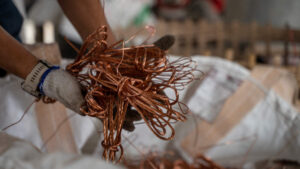Ground Breakers: Coking coal falls hard for a second day in a row as EU considers ban on Russian imports

Pic: Bloomberg Creative / Bloomberg Creative Photos via Getty Images
- Premium Hard Coking Coal prices have dropped over US$70/t in two days
- PHCC FOB Dalrymple Bay Coal Terminal is still fetching US$421/t, four times what it was this time last year
- European Commission mulls suspension of Russian coal imports as war in Ukraine continues
What’s happened to met coal?
Premium hard coking coal, the top of the line steelmaking coal companies like BHP (ASX:BHP) produce out of Queensland soared to ~US$670/t in mid-March.
That came off the back of concerns about Russian supplies following its invasion of Ukraine.
But prices have come crashing back to, well not Earth, but somewhere closer to our stratosphere as buyers have retreated in recent days.
PHCC FOB Dalrymple Bay Coal Terminal, the top quality Australian coal product, have dipped by over US$70/t in the past two days.
According to Fastmarkets MB prices tumbled US$40.37 to US$421.25/t.
That’s around four times what they fetched 12 months ago, so Australian producers won’t be too unhappy right now.
EU looks to restrict Russian coal exports
The dip in both met coal and thermal coal prices over the past fortnight may be an indication as well that Russian supply has not been restricted as much as anxious market participants expected.
That could become more fully realised amid reports the European Commission plans to impose a total ban on coal from Russia.
EC President Ursula von der Leyen announced on Tuesday the EC planned the ban to cut a 4 billion Euro per year revenue stream from Russia, which supplied 19.3% of the EU’s coal imports in 2020.
The escalation of sanctions comes amid claims and reports of war crimes in Ukraine committed by Russian soldiers.
Could this light a fire under coal prices again? It’s hard to say.
Australian coal cargos are so heavily booked in Asia it will likely have little impact on trade flows from the world’s largest coking coal exporter.
Commbank metals and mining analyst Vivek Dhar said India and China could take Russian coal displaced by the ban, while OECD countries will struggle to replace it given a lack of supply increases elsewhere.
In thermal coal markets they will likely have to look to Colombia, South Africa and the USA, which could put on 10Mt, 11Mt and 3.6Mt of extra capacity in 2022 respectively. Russia posts around 90Mtpa of energy coal to Europe, Japan and South Korea.
That said, Dhar is sceptical the new ban will lead to massive price increases like we saw last month.
“Australian thermal coal and coking coal prices suggest that shortage concerns peaked in early to mid‑March. Premium coking coal prices and thermal coal futures have already declined ~42% and ~36% from their peaks respectively,” he said.
“We doubt prices will return to these highs even if the EU formalises their ban on Russian coal imports later this week.
“That’s because the recent peak in coal prices were likely pricing in a more severe reduction in Russian coal exports a few weeks ago.”
Sandfire opens Motheo but investors are looking at zinc’s double edged sword
Sandfire Resources (ASX:SFR) has kicked off mining at its T3 open pit at the new Motheo mine in Botswana, ahead of the start of production in 2023.
It is a key step in the process towards expanding its copper production, with the ~30,000tpa copper and silver mine to add to its soon to close DeGrussa operations in WA and the newly acquired MATSA complex in Spain.
“Pleasingly, we have been able to keep the project schedule on track and on budget despite the persistent labour and supply challenges being experienced across the global mining industry. This is a credit to the team and I would like to commend them for their efforts,” Sandfire managing director Karl Simich said.
“We’re also nearing completion of the Feasibility Study for the 5.2Mtpa Expansion Case at Motheo, which is due for completion in the June Quarter of this year. All the infrastructure currently under construction at Motheo is being built to support this proposed expanded capacity, supporting Sandfire’s plans for Motheo to become the heart of a major new processing hub in the Kalahari Copper Belt.”
The larger MATSA operation is where a lot of the investor focus will be, not just because of its eye watering $2.6 billion purchase price, but also its zinc credits.
SFR expects to produce around 26,000t of copper and 37,000t of zinc in the five months to June 30, the first half year under its ownership.
Record zinc prices in excess of US$4000/t (US$4331/t overnight) give a positive outlook for the zinc component at MATSA.
But it’s a double-edged sword, with high energy and commodity costs seeing smelters increase their treatment charges from US$159/t in 2021 to US$230/t, according to Bloomberg.
At current prices the rewards outweigh the risks for Sandfire.
“Using a $230/t TC vs our current estimate of $191/t has a $8M negative impact on our EBITDA,” RBC analyst Kaan Peker said in a note to clients.
“However, using spot zinc ($1.95/lb) vs our estimate of $1.50/lb would increase EBITDA by ~$40m.”
RBC thinks Sandfire will generate $530m in EBITDA in 2022-23.
“On our estimates, for FY23, ~25% of revenue for SFR is derived from zinc exposure, this increases to 32-35% at spot,” Peker said.
Sandfire Resources (ASX:SFR) share price today:
Related Topics

UNLOCK INSIGHTS
Discover the untold stories of emerging ASX stocks.
Daily news and expert analysis, it's free to subscribe.
By proceeding, you confirm you understand that we handle personal information in accordance with our Privacy Policy.








